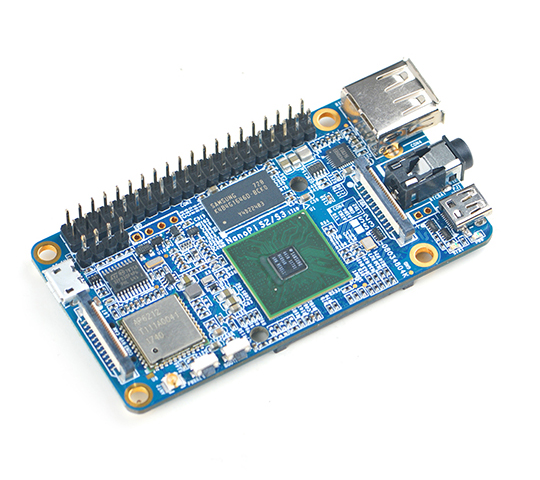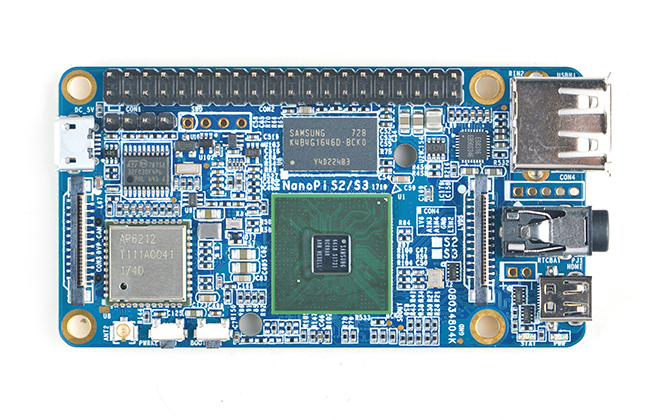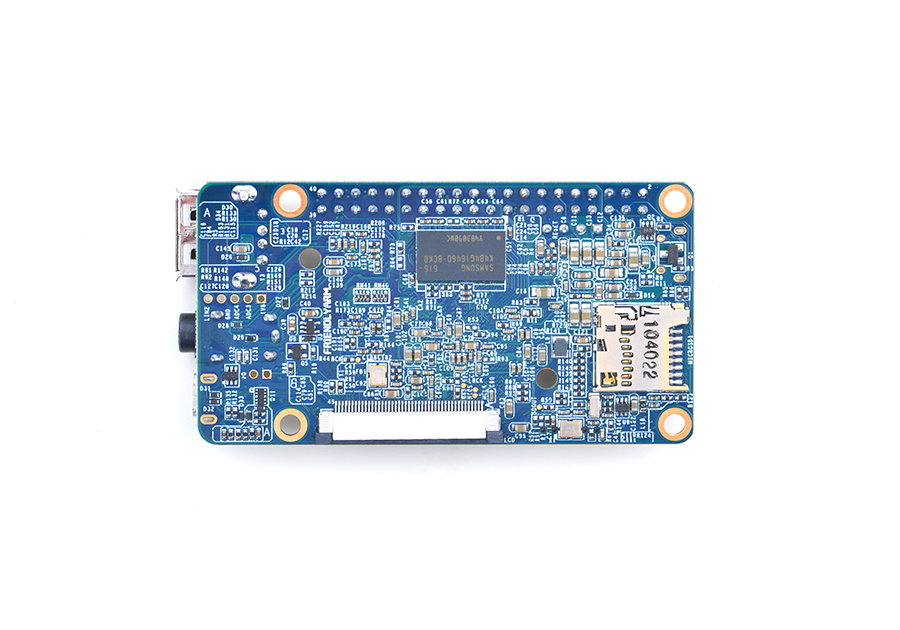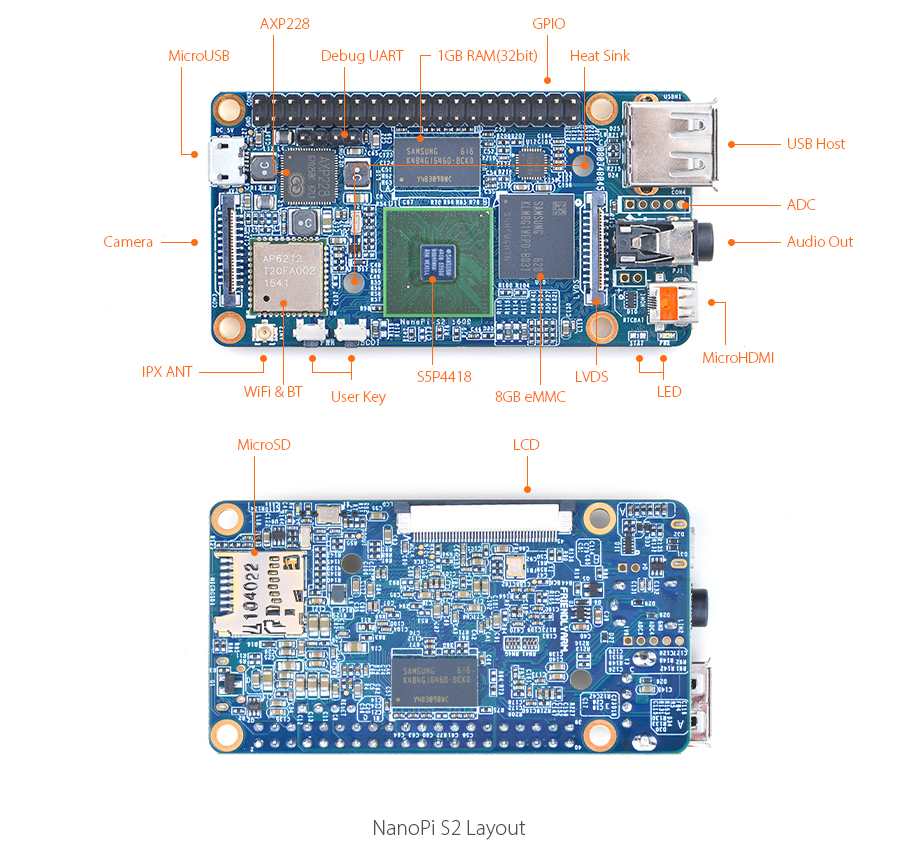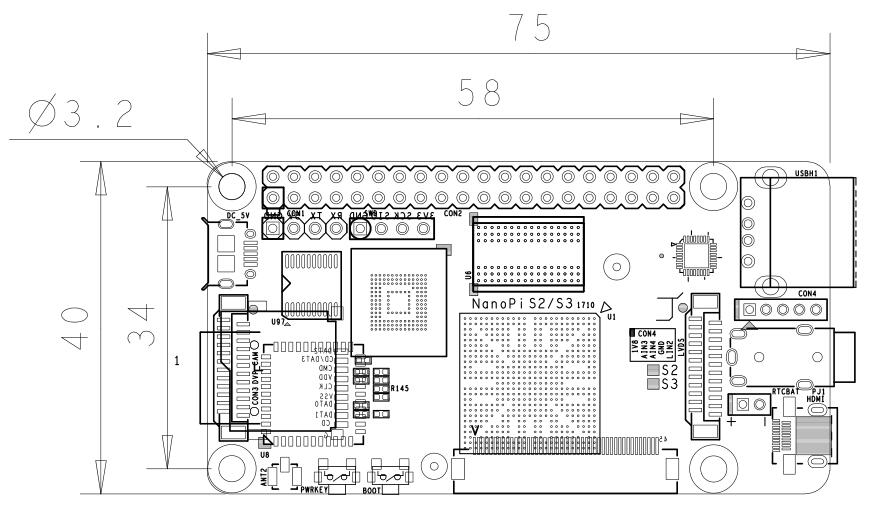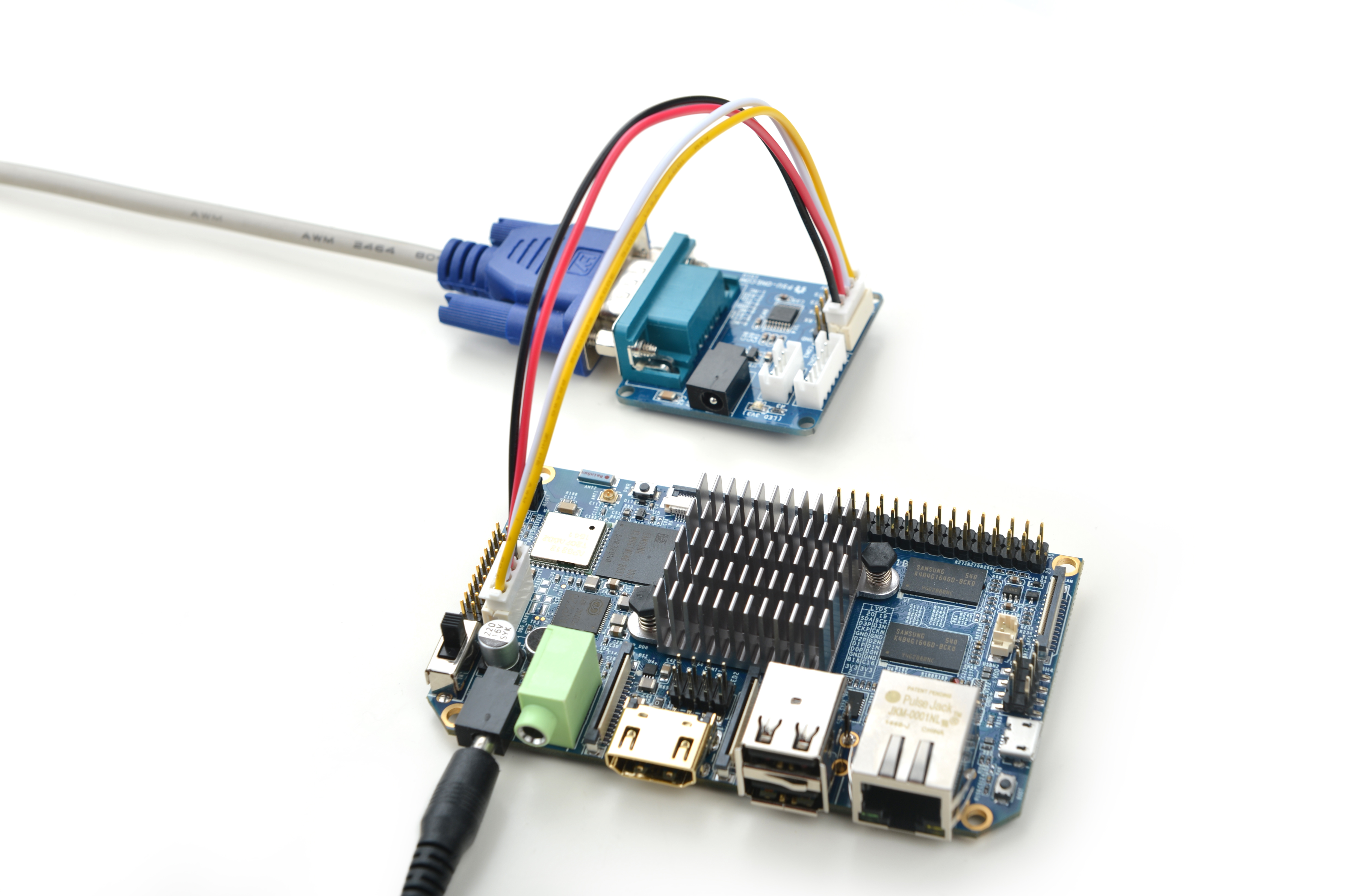Difference between revisions of "NanoPi S2"
(→准备mkimage) |
(→编译Linux kernel) |
||
| Line 391: | Line 391: | ||
</syntaxhighlight> | </syntaxhighlight> | ||
| − | === | + | ===Compile Linux Kernel=== |
| − | ==== | + | ====Compile Kernel==== |
| − | * | + | * Download Kernel Source Code |
<syntaxhighlight lang="bash"> | <syntaxhighlight lang="bash"> | ||
git clone https://github.com/friendlyarm/linux-3.4.y.git | git clone https://github.com/friendlyarm/linux-3.4.y.git | ||
| Line 399: | Line 399: | ||
git checkout nanopi2-lollipop-mr1 | git checkout nanopi2-lollipop-mr1 | ||
</syntaxhighlight> | </syntaxhighlight> | ||
| − | + | The NanoPi S2's kernel source code lies in the "nanopi2-lollipop-mr1" branch. | |
| − | * | + | * Compile Android Kernel |
<syntaxhighlight lang="bash"> | <syntaxhighlight lang="bash"> | ||
make nanopi2_android_defconfig | make nanopi2_android_defconfig | ||
| Line 406: | Line 406: | ||
make uImage | make uImage | ||
</syntaxhighlight> | </syntaxhighlight> | ||
| − | * | + | * Compile Debian Kernel |
<syntaxhighlight lang="bash"> | <syntaxhighlight lang="bash"> | ||
make nanopi2_linux_defconfig | make nanopi2_linux_defconfig | ||
| Line 412: | Line 412: | ||
make uImage | make uImage | ||
</syntaxhighlight> | </syntaxhighlight> | ||
| − | + | After your compilation succeeds a uImage will be generated in the "arch/arm/boot/uImage" directory. This kernel is for HDMI 720P. You can use it to replace the existing uImage.hdmi.<br /> | |
| − | + | If you want to generate a kernel for HDMI 1080P you can do it this way: | |
<syntaxhighlight lang="bash"> | <syntaxhighlight lang="bash"> | ||
touch .scmversion | touch .scmversion | ||
| Line 427: | Line 427: | ||
make uImage | make uImage | ||
</syntaxhighlight> | </syntaxhighlight> | ||
| − | + | After your compilation succeeds a uImage will be generated for HDMI 1080P. You can use it to replace the existing uImage.<br /> | |
| − | + | If you want to generate a kernel for an LCD you can do it this way: | |
<syntaxhighlight lang="bash"> | <syntaxhighlight lang="bash"> | ||
touch .scmversion | touch .scmversion | ||
| Line 440: | Line 440: | ||
make uImage | make uImage | ||
</syntaxhighlight> | </syntaxhighlight> | ||
| − | + | After your compilation succeeds a uImage will be generated for LCDs. You can use it to replace the existing uImage. | |
| − | ==== | + | ====Compile Kernel Modules==== |
| − | + | Android contains kernel modules which are in the "/lib/modules" directory in the system section. If you want to add your own modules to the kernel or you changed your kernel configurations you need to recompile these new modules.<br /> | |
| − | + | Compile Original Kernel Modules: | |
<syntaxhighlight lang="bash"> | <syntaxhighlight lang="bash"> | ||
cd linux-3.4.y | cd linux-3.4.y | ||
make CROSS_COMPILE=arm-linux- modules | make CROSS_COMPILE=arm-linux- modules | ||
</syntaxhighlight> | </syntaxhighlight> | ||
| − | + | Here we have two new modules and we can compile them by following the commands below: | |
<syntaxhighlight lang="bash"> | <syntaxhighlight lang="bash"> | ||
cd /opt/FriendlyARM/s5p4418/android | cd /opt/FriendlyARM/s5p4418/android | ||
./vendor/friendly-arm/build/common/build-modules.sh | ./vendor/friendly-arm/build/common/build-modules.sh | ||
</syntaxhighlight> | </syntaxhighlight> | ||
| − | + | The "/opt/FriendlyARM/s5p4418/android" directory points to the top directory of Android source code. You can get more details by specifying option "-h".<br /> | |
| − | + | After your compilation succeeds new modules will be generated. | |
===编译Android=== | ===编译Android=== | ||
Revision as of 03:13, 25 October 2016
Contents
- 1 Introduction
- 2 Specifications
- 3 Diagram, Layout and Dimension
- 4 Get Started
- 5 Working with Debian
- 6 Make Your Own OS Image
- 7 源代码和固件下载链接
- 8 资源链接
1 Introduction
- The NanoPi S2(S2) is is designed and developed by FriendlyElec for professionals, enterprise users, makers and hobbyists. It is a small board with WiFi, Bluetooth and eMMC.
- It uses the Samsung Quad Core Cortex-A9 S5P4418 SoC with dynamic frequency scaling up to 1.4GHz. It has 1G DDR3 RAM, 802.11 b/g/n WiFi & Bluetooth 4.0 module. Its in-built power management unit uses the AXP228 chip which supports software shutdown. It takes power over the MicroUSB port. It has video input/output interface, 3.5mm audio jack, USB port and MicroSD card slot, serial debug port and ADC pin-header.
- An Android and a Debian images are ready for the NanoPi S2. The Android OS supports HDMI and LCD output.
- The NanoPi S2 has various IO ports which are compatible with Raspberry Pi's GPIOs. Its PCB dimension is 40 * 75 mm. The NanoPi S2 works with most of the modules and OS images that are developed for FriendlyElec's S5P4418 based boards.
2 Specifications
- CPU: S5P4418, dynamic frequency from 400Mhz to 1.4GHz
- PMU Power Management Unit: AXP228. It supports software shutdown and wake-up functions.
- DDR3 RAM: 1GB
- eMMC: 8GB
- Wireless:802.11 b/g/s
- Bluetooth:4.0 dual mode
- MicroSD Slot:x1
- Audio: 3.5mm jack/Via HDMI
- Microphone: Onboard microphone
- USB Host: 1 x USB 2.0 Host Micro USB: 1 x USB 2.0 Client
- LCD Interface: 0.5 mm pitch 45-pin SMT FPC seat, for full-color LCD (RGB: 8-8-8)
- HDMI: microHDMI,1080P60 output
- DVP Camera Interface: 0.5mm pitch 24-pin FPC socket.
- LVDS:2.0mm pitch 20-Pin header
- GPIO1: 2.54mm pitch 40pin, compatible with Raspberry Pi's GPIO. It includes UART, SPI, I2C, PWM, IO and etc
- ADC: onboard ADC pin header
- Serial Debug Port:2.54mm pitch 4-Pin header
- Antenna Interface: IPX
- User Key: 1 x Power , 1 x Reset
- LED: 1 x Power LED, 1 x System LED
- RTC: RTC Pins
- PCB Size(mm): 64 x 56, 6 layer, ENIG
- Power Supply: DC 5V/2A
- OS/Software: u-boot, Android5.1, Debian8
3 Diagram, Layout and Dimension
3.1 Layout
- GPIO1 Pin Description
Pin# Name Pin# Name 1 SYS_3.3V 2 VDD_5V 3 I2C0_SDA 4 VDD_5V 5 I2C0_SCL 6 DGND 7 GPIOD8/PPM 8 UART3_TXD/GPIOD21 9 DGND 10 UART3_RXD/GPIOD17 11 UART4_TX/GPIOB29 12 GPIOD1/PWM0 13 GPIOB30 14 DGND 15 GPIOB31 16 GPIOC14/PWM2 17 SYS_3.3V 18 GPIOB27 19 SPI0_MOSI/GPIOC31 20 DGND 21 SPI0_MISO/GPIOD0 22 UART4_RX/GPIOB28 23 SPI0_CLK/GPIOC29 24 SPI0_CS/GPIOC30 25 DGND 26 GPIOB26 27 I2C1_SDA 28 I2C1_SCL 29 GPIOC8 30 DGND 31 GPIOC7 32 GPIOC28 33 GPIOC13/PWM1 34 DGND 35 SPI2_MISO/GPIOC11 36 SPI2_CS/GPIOC10 37 AliveGPIO3 38 SPI2_MOSI/GPIOC12 39 DGND 40 SPI2_CLK/GPIOC9
The above pin description is different from that of the NanoPi 2. Here is a comparison table:40 pins GPIO comparison table
- Debug Port(UART0)
Pin# Name 1 DGND 2 VDD_5V 3 UART_TXD0 4 UART_RXD0
- DVP Camera Interface Pin Description
Pin# Name 1, 2 SYS_3.3V 7,9,13,15,24 DGND 3 I2C0_SCL 4 I2C0_SDA 5 GPIOB14 6 GPIOB16 8,10 NC 11 VSYNC 12 HREF 14 PCLK 16-23 Data bit7-0
- RGB LCD Interface Pin Description
Pin# Name Description 1, 2 VDD_5V 5V Output, it can be used to power LCD modules 11,20,29, 37,38,39,40, 45 DGND Ground 3-10 Blue LSB to MSB RGB blue 12-19 Green LSB to MSB RGB green 21-28 Red LSB to MSB RGB red 30 GPIOB25 available for users 31 GPIOC15 occupied by FriendlyARM one wire technology to recognize LCD models and control backlight and implement resistive touch, not applicable for users 32 XnRSTOUT Form CPU low when system is reset 33 VDEN signal the external LCD that data is valid on the data bus 34 VSYNC vertical synchronization 35 HSYNC horizontal synchronization 36 LCDCLK LCD clock, Pixel frequency 41 I2C2_SCL I2C2 clock signal, for capacitive touch data transmission 42 I2C2_SDA I2C2 data signal, for capacitive touch data transmission 43 GPIOC16 interrupt pin for capacitive touch, used with I2C2 44 NC Not connected
- Notes
- SYS_3.3V: 3.3V power output
- VDD_5V: 5V power output5V. When the external device’s power is greater than the MicroUSB’s the external device is charging the board otherwise the board powers the external device.The input range is 4.7V ~ 5.6V
- All pins are 3.3V, output current is 5mA
- GPIO1' pin description is different from that of the NanoPi 2. Here is a comparison table40 pins GPIO comparison table
- For more details refer to the document:[]
3.2 Board Dimension
- For more details please refer to the document:NanoPi-S2-1609-dimensions
4 Get Started
4.1 Essentials You Need
Before starting to use your NanoPi S2 get the following items ready
- NanoPi S2
- MicroSD Card/TF Card: Class 10 or Above, minimum 8GB SDHC
- A DC 5V/2A power is a must
- HDMI monitor or LCD
- USB keyboard, mouse and possible a USB hub(or a TTL to serial board)
- A host computer running Ubuntu 14.04 64 bit system
4.2 TF Card We Tested
To make your NanoPi S2 boot and run fast we highly recommend you use a Class10 8GB SDHC TF card or a better one. The following cards are what we used in all our test cases presented here:
- SanDisk TF 8G Class10 Micro/SD TF card:
- SanDisk TF128G MicroSDXC TF 128G Class10 48MB/S:
- 川宇 8G C10 High Speed class10 micro SD card:
4.3 Make an Installation MicroSD Card
4.3.1 Under Windows
Please get the following files from here download link to download image files
- Get a 4G SDHC card and backup its data if necessary
FriendlyARM migrated both Android 5.1 and Android 4.4 to the NanoPi S2. Android 4.4 includes features that professional users usually need: 4G, Ethernet configuration and etc.
For LCD or HDMI output please use the following files: nanopi2-debian-sd4g.img.zip Debian image file nanopi2-android-sd4g.img.zip Android5.1 image file s5p4418-kitkat-sd4g-20160803.img.zip Android4.4 image file Flash Utility: win32diskimager.rar Windows utility. Under Linux users can use "dd"
- Uncompress these files. Insert an SD card(at least 4G) into a Windows PC and run the win32diskimager utility as administrator. On the utility's main window select your SD card's drive, the wanted image file and click on "write" to start flashing the SD card.
- Insert this card into your NanoPi S2's boot slot, press and hold the boot key and power on (with a 5V/2A power source). If the green LED is on and the blue LED is blinking this indicates your NanoPi S2 has successfully booted.
4.3.2 Under Linux Desktop
- 1) Insert your microSD card to your host running Ubuntu and check your SD card's device name
dmesg | tail
Search the messages output by "dmesg" for similar words like "sdc: sdc1 sdc2". If you can find them it means your SD card is recognized as "/dev/sdc". Or you can check that by commanding "cat /proc/partitions".
- 2) Download Flashing Script
git clone https://github.com/friendlyarm/sd-fuse_nanopi2.git cd sd-fuse_nanopi2
- 3) Flash Android Firmware to MicroSD Card
su ./fusing.sh /dev/sdx
(Note: you need to replace "/dev/sdx" with the device name in your system) When you do “git clone” you have to hit “Y” within 10 seconds after it prompts you to download image files otherwise you will miss the download.
- 4) Flash Debian Firmware to MicroSD Card
./fusing.sh /dev/sdx debian
4.3.3 Flash image to eMMC with eflasher
- Download eflasher
Get the eflasher utility s5p4418-eflasher-sd8g-xxx-full.img.7z
This package includes a Ubuntu Core, Debian, Android 5 and Android 4.4 image files;
Get the Windows utility: win32diskimager.rar;
- Flash eflasher Image
Extract the .7z package and you will get .img files.Insert an SD card(at least 4G) into a Windows PC and run the win32diskimager utility as administrator. On the utility's main window select your SD card's drive, the wanted image file and click on "write" to start flashing the SD card.
If your PC runs Linux you can use the dd command to flash a .img file to the SD card;
- Flash image to eMMC
Insert this card into your NanoPi S2, connect the board to an HDMI monitor or an LCD, press and hold the boot key and power on (with a 5V/2A power source) the board. After your board is powered on you will see multiple OS options and you can select an OS to start installation.
4.3.4 Extend NanoPi S2's TF Card Section
- When Debian/Ubuntu is loaded the SD card's section will be automatically extended.
- When Android is loaded you need to run the following commands on your host PC to extend your SD card's section:
sudo umount /dev/sdx? sudo parted /dev/sdx unit % resizepart 4 100 resizepart 7 100 unit MB print sudo resize2fs -f /dev/sdx7
(Note: you need to replace "/dev/sdx" with the device name in your system)
4.3.5 LCD/HDMI Resolution
When the system boots our uboot will check whether it is connected to an LCD or to an HDMI monitor. If it recognizes an LCD it will configure its resolution. Our uboot defaults to the HDMI 720P configuration.
If you want to modify the LCD resolution you can modify file "arch/arm/plat-s5p4418/nanopi2/lcds.c" in the kernel and recompile it.
If your NanoPi S2 is connected to an HDMI monitor and it runs Android it will automatically set the resolution to an appropriate HDMI mode by checking the "EDID". If your NanoPi S2 is connected to an HDMI monitor and it runs Debian by default it will set the resolution to the HDMI 720P configuration. If you want to modify the HDMI resolution to 1080P modify your kernel's configuration as explained above.
4.4 Update Image Files in SD Card From PC Host
If you want to make some changes to the image files in your SD card follow the steps below otherwise you can skip this section.
Insert your SD card into a host PC running Linux, mount the boot and rootfs sections of the SD card and follow the steps below:
1) If you want to change your kernel command line parameters you can do it via the fw_setevn utility under "sd-fuse_nanopi2/tools".
Check the current Command Line:
cd sd-fuse_nanopi2/tools ./fw_printenv /dev/sdc | grep bootargs
Android 5.1.1_r6 starts SELinux. By default it is enforcing. You can change it this way:
./fw_setenv /dev/sdc bootargs XXX androidboot.selinux=permissive
This sets it to "permissive". The "XXX" stands for the original bootargs' value.
2) Update Kernel
Our customized uboot will check the LCD type when it boots.
For a non-Android OS if it recognizes that an LCD is connected to the NanoPi S2 it will load "uImage" from "boot" otherwise it will load "uImage.hdmi".
For Android it doesn't make any difference which display device is detected. You can use your generated uImage to replace the existing one under "boot".
For Debian if your generated kernel is for an LCD you need to replace the existing uImage or if your kernel is for an HDMI monitor you need to replace the existing uImage.hdmi.
4.5 Run Android or Debian
- Insert a MicroSD card with Android/Debian image file into your NanoPi S2, connect the board to an HDMI monitor, press and hold the boot key, power on the board the NanoPi S2 will boot from the SD card. If you can see the blue LED flashing it means your board is working and you will see Android/Debain being loaded on the HDMI monitor.
1)If you connect the NanoPi S2 to an HDMI monitor you need to use a USB mouse and a USB keyboard to operate. If you connect it to an LCD with capacitive touch you can operate directly on the LCD.
2)If you want to do kernel development you need to use a serial communication board, ie a PSU-ONECOM board, which will allow you to operate the board via a serial terminal.
- Here is a setup where we connect a NanoPi S2 to a PC running Ubuntu and Minicom via a serial cable you will see system messages output to the PC’s minicom terminal:
- Under Debian the password for "root" is "fa"
4.6 Login to Debian via VNC & SSH
If your NanoPi S2 is not connected to a display device you can download and install a "VNC Viewer" from here on a mobile phone and login to the NanoPi S2 via VNC. Its default password is "fa123456".
Here is a screenshot which shows how it looks like when users login to the NanoPi S2 from an iPhone via VNC:

You can login via "SSH -l root 192.168.8.1" the default password for "root" is "fa"
5 Working with Debian
5.1 Install Debian Packages
We provide a Debian Jessie image. You can install Jessie's packages by commanding "apt-get". If this is your first installation you need to update the package list by running the following command
apt-get updateYou can install your preferred packages. For example if you want to install an FTP server you can do this:
apt-get install vsftpdNote: you can change your download server by editting "/etc/apt/sources.list". You can get a complete server list from [1]. You need to select the one with "armhf".
6 Make Your Own OS Image
6.1 Install Cross Compiler
Download the compiler package:
git clone https://github.com/friendlyarm/prebuilts.git sudo mkdir -p /opt/FriendlyARM/toolchain sudo tar xf prebuilts/gcc-x64/arm-cortexa9-linux-gnueabihf-4.9.3.tar.xz -C /opt/FriendlyARM/toolchain/
Then add the compiler's directory to "PATH" by appending the following lines in "~/.bashrc":
export PATH=/opt/FriendlyARM/toolchain/4.9.3/bin:$PATH export GCC_COLORS=auto
Execute "~/.bashrc" to make the changes take effect. Note that there is a space after the first ".":
. ~/.bashrcThis compiler is a 64-bit one therefore it cannot be run on a 32-bit Linux machine. After the compiler is installed you can verify it by running the following commands:
arm-linux-gcc -v Using built-in specs. COLLECT_GCC=arm-linux-gcc COLLECT_LTO_WRAPPER=/opt/FriendlyARM/toolchain/4.9.3/libexec/gcc/arm-cortexa9-linux-gnueabihf/4.9.3/lto-wrapper Target: arm-cortexa9-linux-gnueabihf Configured with: /work/toolchain/build/src/gcc-4.9.3/configure --build=x86_64-build_pc-linux-gnu --host=x86_64-build_pc-linux-gnu --target=arm-cortexa9-linux-gnueabihf --prefix=/opt/FriendlyARM/toolchain/4.9.3 --with-sysroot=/opt/FriendlyARM/toolchain/4.9.3/arm-cortexa9-linux-gnueabihf/sys-root --enable-languages=c,c++ --with-arch=armv7-a --with-tune=cortex-a9 --with-fpu=vfpv3 --with-float=hard ... Thread model: posix gcc version 4.9.3 (ctng-1.21.0-229g-FA)
6.2 Compile U-Boot
Download the U-Boot source code and compile it. Note that the github's branch is nanopi2-lollipop-mr1:
git clone https://github.com/friendlyarm/uboot_nanopi2.git cd uboot_nanopi2 git checkout nanopi2-lollipop-mr1 make s5p4418_nanopi2_config make CROSS_COMPILE=arm-linux-
After your compilation succeeds a u-boot.bin will be generated. If you want to test it flash it to your installation SD card via fastboot. Here is how you can do it:
1) On your host PC run "sudo apt-get install android-tools-fastboot" to install the fastboot utility;
2) Connect your NanoPi S2 to your host PC via a serial cable (e.g. PSU-ONECOME). Press the enter key within two seconds right after you power on your NanoPi S2 and you will enter uboot's command line mode;
3) After type in "fastboot" and press "enter" you will enter the fastboot mode;
4) Connect your NanoPi S2 to this host PC via a microUSB cable and type in the following command to flash u-boot.bin:
fastboot flash bootloader u-boot.bin
Warning: you cannot update this SD card by commanding "dd". This command will cause trouble when booting the NanoPi S2.
6.3 Prepare mkimage
You need the mkimage utility to compile a U-Boot source code package. Make sure this utility works well on your host before you start compiling a uImage.
You can install this utility by either commanding "sudo apt-get install u-boot-tools" or following the commands below:
cd uboot_nanopi2 make CROSS_COMPILE=arm-linux- tools sudo mkdir -p /usr/local/sbin && sudo cp -v tools/mkimage /usr/local/sbin
6.4 Compile Linux Kernel
6.4.1 Compile Kernel
- Download Kernel Source Code
git clone https://github.com/friendlyarm/linux-3.4.y.git cd linux-3.4.y git checkout nanopi2-lollipop-mr1
The NanoPi S2's kernel source code lies in the "nanopi2-lollipop-mr1" branch.
- Compile Android Kernel
make nanopi2_android_defconfig touch .scmversion make uImage
- Compile Debian Kernel
make nanopi2_linux_defconfig touch .scmversion make uImage
After your compilation succeeds a uImage will be generated in the "arch/arm/boot/uImage" directory. This kernel is for HDMI 720P. You can use it to replace the existing uImage.hdmi.
If you want to generate a kernel for HDMI 1080P you can do it this way:
touch .scmversion make nanopi2_linux_defconfig make menuconfig Device Drivers --> Graphics support --> Nexell Graphics --> [ ] LCD [*] HDMI (0) Display In [0=Display 0, 1=Display 1] Resolution (1920 * 1080p) ---> make uImage
After your compilation succeeds a uImage will be generated for HDMI 1080P. You can use it to replace the existing uImage.
If you want to generate a kernel for an LCD you can do it this way:
touch .scmversion make nanopi2_linux_defconfig make menuconfig Device Drivers --> Graphics support --> Nexell Graphics --> [*] LCD [ ] HDMI make uImage
After your compilation succeeds a uImage will be generated for LCDs. You can use it to replace the existing uImage.
6.4.2 Compile Kernel Modules
Android contains kernel modules which are in the "/lib/modules" directory in the system section. If you want to add your own modules to the kernel or you changed your kernel configurations you need to recompile these new modules.
Compile Original Kernel Modules:
cd linux-3.4.y make CROSS_COMPILE=arm-linux- modules
Here we have two new modules and we can compile them by following the commands below:
cd /opt/FriendlyARM/s5p4418/android ./vendor/friendly-arm/build/common/build-modules.sh
The "/opt/FriendlyARM/s5p4418/android" directory points to the top directory of Android source code. You can get more details by specifying option "-h".
After your compilation succeeds new modules will be generated.
6.5 编译Android
- 搭建编译环境
搭建编译Android的环境建议使用64位的Ubuntu 14.04,安装需要的包即可。
sudo apt-get install bison g++-multilib git gperf libxml2-utils make python-networkx zip sudo apt-get install flex libncurses5-dev zlib1g-dev gawk minicom
更多说明可查看 https://source.android.com/source/initializing.html 。
- 下载源代码
Android源代码的下载需要使用repo,其安装和使用请查看 https://source.android.com/source/downloading.html 。
mkdir android && cd android repo init -u https://github.com/friendlyarm/android_manifest.git -b nanopi2-lollipop-mr1 repo sync
其中“android”是指工作目录。
- 编译系统
source build/envsetup.sh lunch aosp_nanopi2-userdebug make -j8
编译成功完成后,目录 out/target/product/nanopi2/ 下包含可用于烧写的image文件。
filename partition Description boot.img boot - cache.img cache - userdata.img userdata - system.img system - partmap.txt - 分区描述文件
- 烧写到SD卡
如果是采用SD卡启动Android,可复制编译生成的image文件到sd-fuse_nanopi2/android/ 下,使用脚本即可烧到到SD卡,具体请查看#在Linux Desktop下通过脚本制作。
7 源代码和固件下载链接
8 资源链接
- 《创客秘籍》创客秘籍
- 《创客秘籍-02》创客秘籍-02
- 《创客秘籍-03》创客秘籍-03
- Schematic (NanoPi-S2-1609-Schematic)
- S5P4418 Datasheet (S5P4418_Datasheet_0.1.pdf)
- 模块介绍以及开发文档:
- 按键模块
- LED模块
- 模数转换
- 继电器模块
- 三轴重力加速度模块
- 三轴数字指南针模块
- 温度传感器模块
- 温湿度传感器模块
- 蜂鸣器
- 摇杆模块(Joystick)
- I2C(PCF8574)+LCD1602
- 声音传感器
- 超声波模块
- GPS模块
- 迷你扩展板Matrix - Compact Kit
- 火焰传感器
- CAM500 500万像素摄像头
- 滚珠开关模块
- 2'8 SPI Key TFT 2.8寸spi液晶屏
- 红外计数模块
- 红外接收模块
- 电机驱动器模块
- MQ-2 烟雾传感器模块
- MQ-3 气体传感器
- 单点电容式数字触摸传感器模块
- 光敏电阻模块
- 电位器模块
- 压力传感器模块
- RGB LED
- RTC模块
- Rotary Encoder
- 土壤湿度检测传感器模块
- 热敏电阻模块
- USB WiFi
- 水位/水滴识别检测传感器模块
